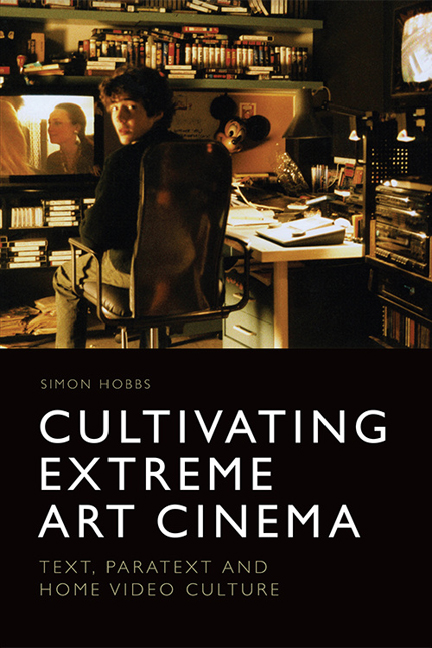Book contents
- Frontmatter
- Contents
- List of Figures
- Acknowledgements
- 1 Introduction
- 2 Art and Exploitation: Crossover, Slippage and Fluidity
- 3 Early Extremity on DVD: History, Precursors and Exploitation Auteurs
- 4 Weekend and Cannibal Holocaust: Art, Ballyhoo and Remediation
- 5 Salò, Or the 120 Days of Sodom and Ilsa, the Wicked Warden: Fascism, Pornography and Disgust
- 6 Contemporary Extremity on DVD: Trends, Hard-core and Geographic Mobility
- 7 Michael Haneke: Glaciation, Legitimacy and Transgression
- 8 Lars von Trier: Provocation, Condemnation and Confrontation
- 9 Conclusion
- Bibliography
- Index
3 - Early Extremity on DVD: History, Precursors and Exploitation Auteurs
Published online by Cambridge University Press: 28 April 2021
- Frontmatter
- Contents
- List of Figures
- Acknowledgements
- 1 Introduction
- 2 Art and Exploitation: Crossover, Slippage and Fluidity
- 3 Early Extremity on DVD: History, Precursors and Exploitation Auteurs
- 4 Weekend and Cannibal Holocaust: Art, Ballyhoo and Remediation
- 5 Salò, Or the 120 Days of Sodom and Ilsa, the Wicked Warden: Fascism, Pornography and Disgust
- 6 Contemporary Extremity on DVD: Trends, Hard-core and Geographic Mobility
- 7 Michael Haneke: Glaciation, Legitimacy and Transgression
- 8 Lars von Trier: Provocation, Condemnation and Confrontation
- 9 Conclusion
- Bibliography
- Index
Summary
As expressed in the Introduction, exploring extreme art cinema through a historical lens is central to understanding its development both textually and paratextually. Surveying the remediation of a series of films that can be loosely labelled ‘early extremity’ (as their production occurred prior to the ‘boom period’ in the mid- to late-1990s), this chapter will extend existing conversations surrounding the marketing traditions of art and exploitation cinema while offering a more historically expansive extreme art film category. When looking into the ways transgressive art films are packaged for contemporary audiences, I draw attention to instances wherein the art tradition prevails; cases whereby distributors borrow the ‘mask’ of exploitation cinema; texts that forego their art lineage completely; and those films that are welcomed back into the art film fold and repaired within its customs. Comparatively, I look at the paratextual presentation of noteworthy exploitation films, examining how the exploitation tradition is both revitalised on DVD and Blu-ray, and suppressed in favour of more complex and culturally ambiguous paratextual presentations.
The aim of this chapter is not to provide an extensive history of extreme art film production. Rather, I want to explore how the forerunners to the current extreme art film trend have been paratextualy represented. In doing so I can determine whether historical examples of extremity become ‘gimmicked’, and the frequency with which the commercial persona of these films are manipulated to fit contemporary standards and expectations. In this sense, the paratextuality of the film, and the manner in which it utilises either ‘high’ or ‘low’ cultural signifiers, is the focus. It is my hope that this method will allow for better insight into how extremity becomes a commercial signifier, a displayable and relatable symbol of textual transgression. However, though this is the case, there is a secondary outcome to the methodology employed throughout this chapter. Through the selection process, this chapter exposes art cinema's historical preoccupation with extremity as well as exploitation cinema's adoption of ‘highbrow’ techniques. As such, this chapter offers a revaluation of both art and exploitation traditions, providing a snapshot of particular points of slippage both textually and paratextually.
- Type
- Chapter
- Information
- Cultivating Extreme Art CinemaText, Paratext and Home Video Culture, pp. 41 - 62Publisher: Edinburgh University PressPrint publication year: 2018



